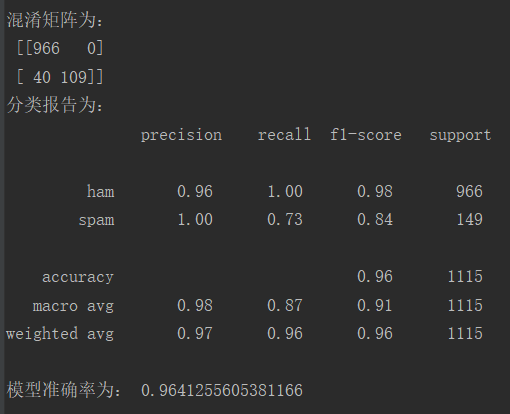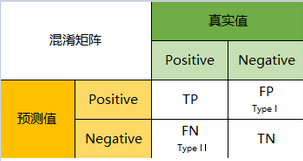1.读取
sms = open("SMSSpamCollection", 'r', encoding='utf-8') # 数据读取 sms_data = [] sms_label = [] csv_reader = csv.reader(sms, delimiter=' ') for line in csv_reader: # 预处理 sms_label.append(line[0]) sms_data.append(preprocessing(line[1])) sms.close()
2.数据预处理
def get_wordnet_pos(treebank_tag): # 根据词性,生成还原参数pos if treebank_tag.startswith('J'): return nltk.corpus.wordnet.ADJ elif treebank_tag.startswith('V'): return nltk.corpus.wordnet.VERB elif treebank_tag.startswith('N'): return nltk.corpus.wordnet.NOUN elif treebank_tag.startswith('R'): return nltk.corpus.wordnet.ADV else: return nltk.corpus.wordnet.NOUN def preprocessing(text): tokens = [] tokens = [word for sent in nltk.sent_tokenize(text) for word in nltk.word_tokenize(sent)] # 去除停用词 stops = stopwords.words("english") tokens = [token for token in tokens if token not in stops] # 大小写 tokens = [token.lower() for token in tokens if len(token) >= 3] # 词性标注 tag = nltk.pos_tag(tokens) # 词性还原 lmtzr = WordNetLemmatizer() # 定义还原对象 tokens = [lmtzr.lemmatize(token, pos=get_wordnet_pos(tag[i][1])) for i, token in enumerate(tokens)] preprocessed_text = ' '.join(tokens) return preprocessed_text # 返回处理完成后的文本
3.数据划分—训练集和测试集数据划分
from sklearn.model_selection import train_test_split
x_train,x_test, y_train, y_test = train_test_split(data, target, test_size=0.2, random_state=0, stratify=y_train)
4.文本特征提取
sklearn.feature_extraction.text.CountVectorizer
sklearn.feature_extraction.text.TfidfVectorizer
from sklearn.feature_extraction.text import TfidfVectorizer
tfidf2 = TfidfVectorizer()
观察邮件与向量的关系
向量还原为邮件
##向量化 def tfidf(x_train, x_test): tfidf2 = TfidfVectorizer() # 将邮件内容转换为向量 x_train = tfidf2.fit_transform(x_train) x_test = tfidf2.transform(x_test) # 转成数组后查看测试集维度 print('训练集维度: ', x_train.toarray().shape) print('测试集维度: ', x_test.toarray().shape) # tfidf2.vocabulary_ # 词袋的词语的统计字典,(单词,单词位置) # 将向量还原成邮件 a = np.flatnonzero(x_train.toarray()[0]) # 获取x_train中第一行非0的值的位置列表 print("非零元素的位置", a) print("向量的非零元素:", x_train.toarray()[0][a]) b = tfidf2.vocabulary_ #词汇表 key_list = [] for key, value in b.items(): if value in a: key_list.append(key) print("非零元素对应的单词", key_list) print("向量化之前的邮件", x_traincp ) return x_train, x_test
结果为:

4.模型选择
from sklearn.naive_bayes import GaussianNB
from sklearn.naive_bayes import MultinomialNB
说明为什么选择这个模型?
def model_choose(x_train, y_train, x_test, y_test): mnb = MultinomialNB() mnb.fit(x_train, y_train) y_mnb = mnb.predict(x_test) print("预测准确率为:", sum(y_mnb == y_test) / len(y_test)) return y_mnb
结果为:

选择模型应该通过模型数据的特点来进行选择。因为用高斯贝叶斯模型进行处理的数据,基本是符合正态分布的,而我们处理的数据是单词出现的频率(单词对文档的重要性),是概率性的数据,并不符合正态分布的规则,所以选择多项式贝叶斯模型。
5.模型评价:混淆矩阵,分类报告
from sklearn.metrics import confusion_matrix
confusion_matrix = confusion_matrix(y_test, y_predict)
说明混淆矩阵的含义
from sklearn.metrics import classification_report
说明准确率、精确率、召回率、F值分别代表的意义
def classify(y_mnb, y_test): cm = confusion_matrix(y_test, y_mnb) print("混淆矩阵为: ", cm) cr = classification_report(y_test, y_mnb) print("分类报告为: ", cr) print("模型准确率为:", (cm[0][0] + cm[1][1]) / np.sum(cm))
结果为:

(1)混淆矩阵:混淆矩阵(Confusion Matrix):
通过这四个指标,我们可以得出混淆矩阵,这四个指标分别是:
· 真实值是positive,模型认为是positive的数量(True Positive=TP) (966)
· 真实值是positive,模型认为是negative的数量(False Negative=FN):这就是统计学上的第二类错误(Type II Error)(49)
· 真实值是negative,模型认为是positive的数量(False Positive=FP):这就是统计学上的第一类错误(Type I Error)(0)
· 真实值是negative,模型认为是negative的数量(True Negative=TN)(109)
(2)准确率:被分对的样本数除以所有的样本数,通常来说,正确率越高,分类器越好。(TP+TN)/总
(3)精确率:表示被分为正例的示例中实际为正例的比例。 TP/(TP+FP)
(4)召回率 :召回率是覆盖面的度量,度量有多个正例被分为正例。TP/(TP+FN)
(5)F值 : 精确率 * 召回率 * 2 / ( 精确率 + 召回率) 。F值就是准确率(P)和召回率(R)的加权调和平均。
6.比较与总结
如果用CountVectorizer进行文本特征生成,与TfidfVectorizer相比,效果如何?
CountVectorizer:只考虑每个单词出现的频率;然后构成一个特征矩阵,每一行表示一个训练文本的词频统计结果。
TfidfVectorizer:除了考量某词汇在本文本出现的频率,还关注包含这个词汇的其它文本的数量。
相比之下,训练文本的数量越多,TfidfVectorizer这种特征量化方式就更有优势,而且TfidfVectorizer可以削减高频没有意义的词汇,应用于实际更有意义,实际效果也会更好。